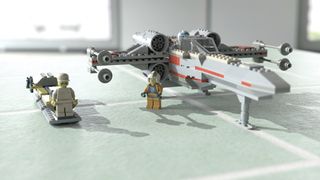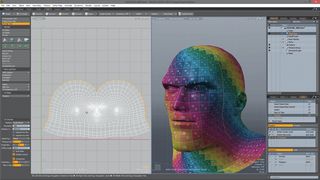Why you can trust Creative Bloq

After last year's benchmark release of Modo 701, which brought a range of new features such as particles, as well as a more refined UI, Modo finally felt that it had come of age. In a vastly changing 3D market where pricing models are changing and applications are disappearing (farewell Softimage), what can The Foundry add to entice new and existing users to upgrade?
This is the first version of Modo that has had a full product cycle as a product of The Foundry, alongside Mari, Nuke and Hiero. Interoperability from Modo to its brethren has been improved with better colour management based on the Open colour I/O which allows conformity between Nuke and Modo, with LUTS being available in the Live Preview for the first time.
There is a new Diffuse Coefficient outputs, which allows more options for compositing in Nuke. There is also now UDIM import, which makes the importing of Mari work into Modo much simpler. It would have been nice to see Ptex integrated into Modo to enable seamless texture painting support between Mari and Modo, but if both are viewed as standalone or pipeline tools, the extra UV support is welcome.
Speaking of UVs, Modo has always had an excellent UV unwrapping system which has been improved in Modo 801, with a new set of unwrap and relax tools, which along with a range of new texture baking options make round tripping to Modo from another 3D application to create your UVs arguably quicker than managing UVs in another 3D app.

New nodal shader system
Dynamics, animation, instancing have all received additions, but the biggest new feature in Modo 801 is undoubtably the new nodal shader system.
Thankfully this doesn't replace the Shader Tree, instead it augments it. Working in the same schematic format as the rest of the nodal workflows in Modo, once you have got past the initial learning curve, complex materials can be made quickly, and offer a wider range of material options which can be made interactive with help from such tools as the new Shader Input node.
More importantly, huge efficiencies can also be made in texture management by using the nodal textures, as one node can be used to drive multiple materials simultaneously on different channels.

Plug-in support
In the past year, Modo has started to see some serious plug-in support, some such as MeshFusion have been developed for The Foundry, while others such as Octane, HDR Light Studio and Substance Designer are from third parties. And while Modo may not have all the features of Maya or Cinema 4D, with the schematic viewport, animation tools and mesh deformers, this ecosystem starts to make Modo feel less of an outlier in the 3D world and more of a full project application punching above its weight.
It costs just $1,495 (£999), that's less than half of the price of some of its competitors, which makes it excellent value as well. With new presets, snapping and UI improvements (although it would have been great to have Open SubDiv support), as well as a deep overhaul of the already responsive and excellent render engine, and live preview, the first 'Foundry Modo' is still fun to use and the new nodal shader system alone is worth the price of the upgrade.
Words: Mike Griggs
Mike Griggs is a concept 3D, VFX and motion graphics artist working across TV, exhibition and digital design. This article originally appeared in 3D World issue 184 - on sale now!

Thank you for reading 5 articles this month* Join now for unlimited access
Enjoy your first month for just £1 / $1 / €1
*Read 5 free articles per month without a subscription

Join now for unlimited access
Try first month for just £1 / $1 / €1
The Creative Bloq team is made up of a group of design fans, and has changed and evolved since Creative Bloq began back in 2012. The current website team consists of eight full-time members of staff: Editor Georgia Coggan, Deputy Editor Rosie Hilder, Ecommerce Editor Beren Neale, Senior News Editor Daniel Piper, Editor, Digital Art and 3D Ian Dean, Tech Reviews Editor Erlingur Einarsson, Ecommerce Writer Beth Nicholls and Staff Writer Natalie Fear, as well as a roster of freelancers from around the world. The ImagineFX magazine team also pitch in, ensuring that content from leading digital art publication ImagineFX is represented on Creative Bloq.
